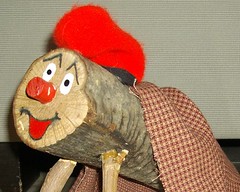 Everyone who has visited a Catalan Christmas market (the most well-known one has to be Santa Llúcia held in the Avinguda de la Catedral in Barcelona) must have noticed these cute, decorated logs. The ones which are being sold are highly standardized: a round log lifted up on two little pawns, with a painted face and prominent nose. And then a barretina (a red Catalan peasant hat) on the "head" and a small blanket over the "back" in order not to be cold.
Everyone who has visited a Catalan Christmas market (the most well-known one has to be Santa Llúcia held in the Avinguda de la Catedral in Barcelona) must have noticed these cute, decorated logs. The ones which are being sold are highly standardized: a round log lifted up on two little pawns, with a painted face and prominent nose. And then a barretina (a red Catalan peasant hat) on the "head" and a small blanket over the "back" in order not to be cold.It has not always been this way. Originally, the tió de nadal was an ordinary log taken in for Christmas, dried out and then burnt step by step. However, before it was put into the fireplace the children got an opportunity to make it "poop out" (cagar) Christmas sweets. I choose to translate torró as Christmas sweets, since the term in Catalan seem to cover not only the Spanish version of nougat, but also many kinds of chocolate.
Nowadays, very few Christmas logs end up being burnt, but the tió de Nadal is one of the main elements of the Catalan Christmas celebrations. In schools, the smallest children practice the typical chants and learn how to feed the tió (in the past, they had to make do with the simplest of vegetables, but today mandarins are a favourite since the peel left behind so clearly shows that they have eaten). The feeding usually starts December 8, on the day of the immaculate conception (la puríssima), but only about dinner time on Christmas eve can tió be expected to poop. What usually comes out are things which the family can enjoy together - Christmas sweets, cava or a new figure to the nativity scene (pessebre) of the house - but there can also be small toys. The children can repeat the singing and beating several times until it finally tió poops out a piece of pickled herring (arengades) or a garlic to mark the end of the ceremony for this year.
To have a Christmas log used to be a family tradition and there are therefore a rich variety of chants. This is the version which children learn at school in Vilanova i la Geltrú:
Caga tió
avellanes i torró,
no caguis arengades
que són massa salades,
caga torrons
que són més bons!
Which I would translate as:
Poop, Christmas log!
hazelnuts and Christmas sweets
Don’t poop pickled herring
which is too salty
Poop Christmas sweets
of the best kind.
- - -
A modern invention is to organize so called cagations popular, public events where children have a chance to give a beating to a giant Christmas log. Catalunya Radio has refined this further and created the solidarity tió (el tió solidari) which tours around in order to collect food for people in need. Just before Christmas last year it visited us here Vilanova and managed to collect 900 kg of rice, pasta and dried vegetables.
- - -
CAT - Festes.org: El tió
CAT - Festes.org: Cançons per fer cagar el tió
CAT – Festes.org: Era soca de nadau
CAT – Wikipedia: Tió de nadal
ENG – Wikipedia: Tió de nadal (Christimas Log)
ENG - YouTube: Caga tió – Catalan Christmas Log
- - -
Technorati tags: Barcelona, Catalonia, Vilanova,

No comments:
Post a Comment